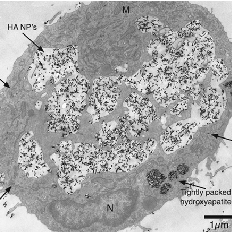Bone-like nanoparticle drug carriers: does aggregation make them dangerous?
If you’ve heard much about Nanotechnology then you may also have heard about the huge impact Nanotech can make on medicine in the near future. One area that may be particularly affected is drug delivery: nano-sized “capsules” of drugs could potentially lead to much more efficient, quicker delivery with reduced side-effects. Or, alternatively, such “capsules” could deliver drugs more slowly over a longer period of time. This can be useful when injecting vaccines and other medications: one injection can replace several if the right nano drug carriers are used. This is the kind of carriers I am studying: slow-release nano-sized drug capsules.
To make these capsules slow-release we choose hydroxyapatite (HA) nanoparticles with even smaller pores than normal. HA is used in lots of medical applications, such as hip prosthesis binding agents and drug delivery capsules as it is very similar to bone and so the body is very accepting of its presence (other materials can be rejected by the body and lead to allergic-type reactions).
However, there is one potential problem with using HA nanoparticles. As a result of their size and special properties, nanoparticles sometimes don’t behave in the way that normal materials would and it seems that HA particles can be slightly toxic to cells in the body if they start to clump together, or aggregate.
My research focuses on understanding how the nanoparticles aggregate and how this affects their toxicity to cells in the body. For this I combine approaches from Physics, Chemistry, Materials Science and Biology, such as electron microscopy, X-ray diffraction, toxicity assays and particle sizing techniques. These are combined to provide an overview of how aggregation affects toxicity. Initial findings suggest that there is a strong correlation between the two and that this may help to understand nanoparticle toxicology as a whole.

Further information: http://www.pdn.cam.ac.uk/caic/index.shtml

